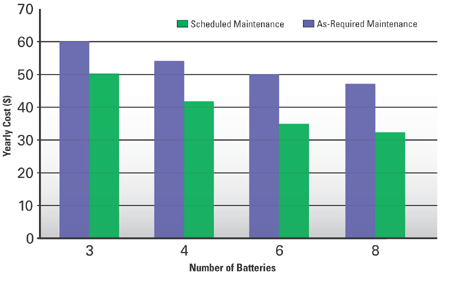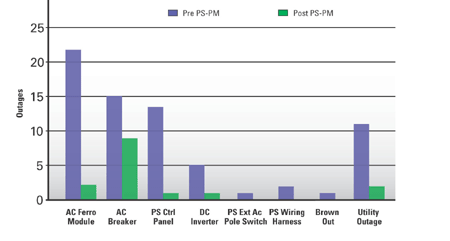The Bottom Line on Batteries
Performing regular routine power supply preventive maintenance is a bit like flossing every day and getting an annual check-up. Virtually everyone believes in the value, but not everyone manages to be conscientious enough to benefit from the regime. Maintenance is easy to ignore. The cost of not performing maintenance is hidden, and the rewards are obscure. The day-to-day competitive pressures that face cable operations managers make it all too easy to put regular maintenance on the back burner. Tools are available now, however, that help keep maintenance current by automating scheduling and field data collection. Significant savings are available if a comprehensive maintenance program is implemented. Quantitative savings be achieved in three areas: The weakest link in a cable distribution network, and arguably the components requiring the most maintenance, are standby power supplies. Telephony and high-speed data have dramatically increased the importance of a cable system being always on. Getting a handle on the cost of maintenance (as well as the hidden costs of not doing it) requires a few assumptions and calculations. Industry surveys indicate that average lead-acid battery life is two and a half years.1 It is possible, however, with regular maintenance to extend battery life to five years. Does doubling the life of the battery justify those extra maintenance visits? Calculating the savings If the costs of the battery as well as the costs of both routine and unscheduled truck rolls are known, the benefits can be calculated. Assume that the replacement cost of a battery is $100; the cost of a scheduled maintenance visit is $45 dollars; and the cost of an unscheduled visit is $150. The reasons that unscheduled visits are more expensive are: Table 1 shows the yearly cost of ownership performing minimum visits—only visiting the power supply when the battery needs to be replaced. TABLE 1: As-Needed Maintenance

Cost of unscheduled truck roll = $150; Replacement cost of battery = $100; Truck roll frequency = once every 2.5 years. Table 2 shows the same yearly cost of ownership assuming semi-annual maintenance visits. TABLE 2: Twice Yearly Scheduled Maintenance

Cost of scheduled truck roll = $45; Replacement cost of battery = $100; Truck roll frequency = once every six months. The maintenance costs are calculated by multiplying the cost of the truck roll by the frequency of truck rolls and then dividing by the number of batteries per supply. The battery cost is the replacement cost of the battery divided by the expected lifetime. Finally, the total ownership cost per battery-year is the sum of the maintenance cost and the battery cost. Figure 1 summarizes the results. It can be seen that the savings resulting from increased battery life outweigh the additional cost of regularly scheduled maintenance visits, even for three-battery supplies. For eight-battery supplies, the savings are even more significant. For example, in a system with 1,100 power supplies using eight-battery backup, the savings would be as follows: FIGURE 1: As-Needed vs. Preventive Maintenance Cost per Battery
 This accounts for only a small part of the savings achieved, because the only factor examined so far is battery lifetime. Reducing system outages Figure 2 shows actual outage data for one system that implemented a comprehensive power supply maintenance program. The figure shows the number of truck rolls for the first five months of two consecutive years. Along the x-axis are the different power supply-related outage causes. The y-axis shows the number of outages attributed to each cause for two different five-month periods. FIGURE 2: Effect of Power Supply Preventive Maintenance
This accounts for only a small part of the savings achieved, because the only factor examined so far is battery lifetime. Reducing system outages Figure 2 shows actual outage data for one system that implemented a comprehensive power supply maintenance program. The figure shows the number of truck rolls for the first five months of two consecutive years. Along the x-axis are the different power supply-related outage causes. The y-axis shows the number of outages attributed to each cause for two different five-month periods. FIGURE 2: Effect of Power Supply Preventive Maintenance
 The first year was prior to implementing a maintenance program, and the second year was after. Figure 2 shows that the number of power supply-related outages was reduced from 70 to 15. If the data are extrapolated to a 12-month period, the reduction would be from 168 to 36 or 132 prevented outages per year. Assuming a $150 cost per truck roll, the yearly savings are:
The first year was prior to implementing a maintenance program, and the second year was after. Figure 2 shows that the number of power supply-related outages was reduced from 70 to 15. If the data are extrapolated to a 12-month period, the reduction would be from 168 to 36 or 132 prevented outages per year. Assuming a $150 cost per truck roll, the yearly savings are:
- 132 prevented truck rolls * $150 per truck roll = $19,800 savings.
This savings is based on one system’s results. As they say, your mileage will vary. Customer retention savings The savings in longer battery life and reduced truck rolls represent “hard savings” to the cable operations manager. The purpose of battery backed up power supplies as well as preventive maintenance is to provide a high level of service availability to the customer. The quality of service is designed to maximize customer retention. One metric often used is that every service outage results in one lost customer. If the average customer revenue is $60 per month, that equates to $720 per year. From the previous data, reducing outages by 132 per year results in savings of:
- $720 income per customer * 132 lost customers = $95,040 lost revenue per year.
While these “soft savings” usually are not attributed to operations, it should be clear that quality of service has a direct impact on the bottom line. Savvy cable system managers will use this to justify spending resources on preventive maintenance. We’ve looked at three key areas where implementing comprehensive power supply preventive maintenance will result in savings to the cable operator. The data has been extrapolated from an actual system that has approximately 1,100 power supplies with eight batteries each. This system achieved $257,840.00 in total savings as summarized in Table 3. TABLE 3: Total Savings Related to Power Supply Preventive Maintenance Program*

* Based on system of 1,100 power supplies with eight batteries each. Conclusion The cable industry has undergone an extended period of major upgrades and rebuilds. Attention now is being focused on maximizing the return on the investment in the cable plant infrastructure. Because battery backed up power supplies represent one of the most critical components in that infrastructure, operators are served well by implementing effective programs to maintain them. Cliff Brown, P.E., is founder and president at Tec-Trac Inc. Email him at cliff.brown@tec-trac.com. 1. R. Marcotte, “Getting the Lead In,” CED, March 1999.